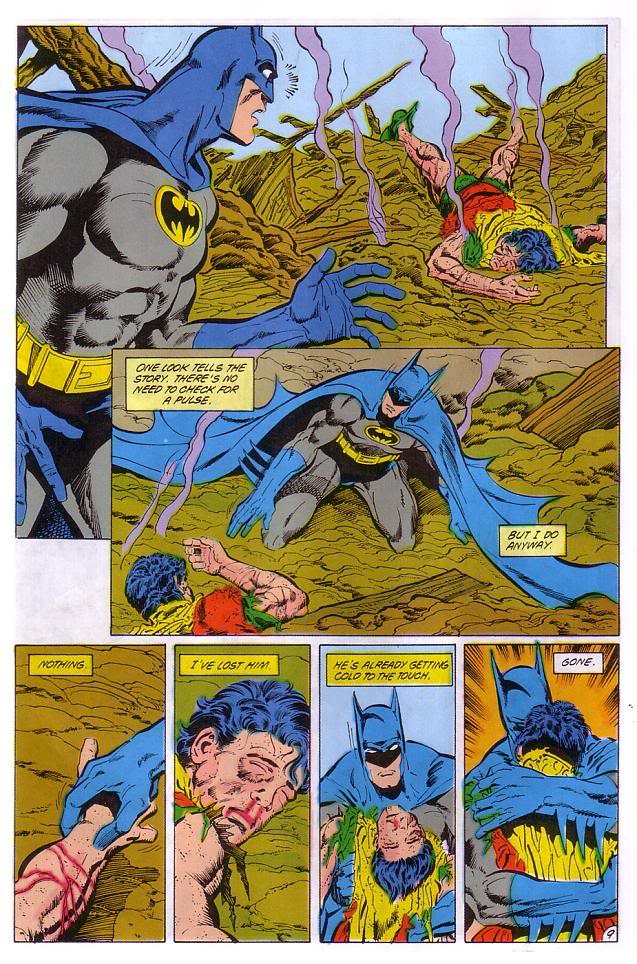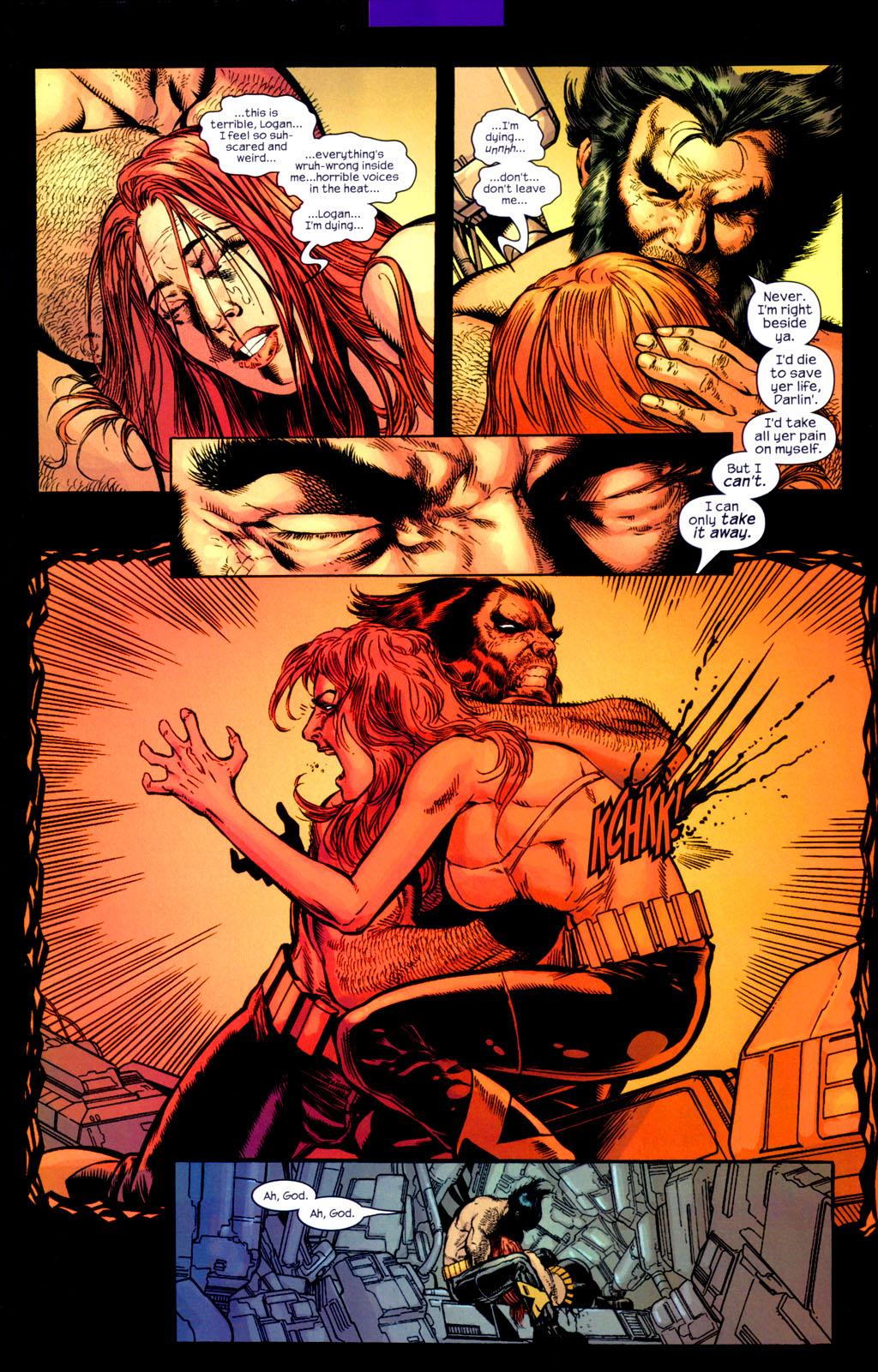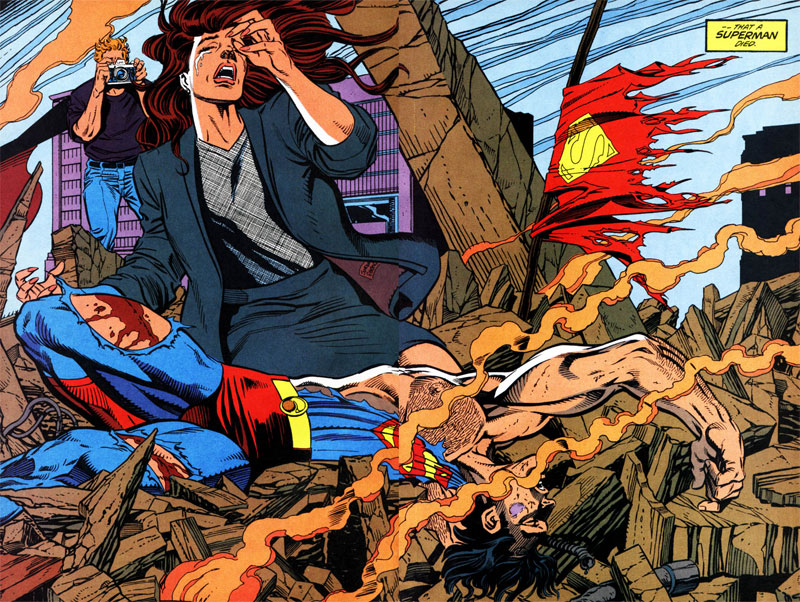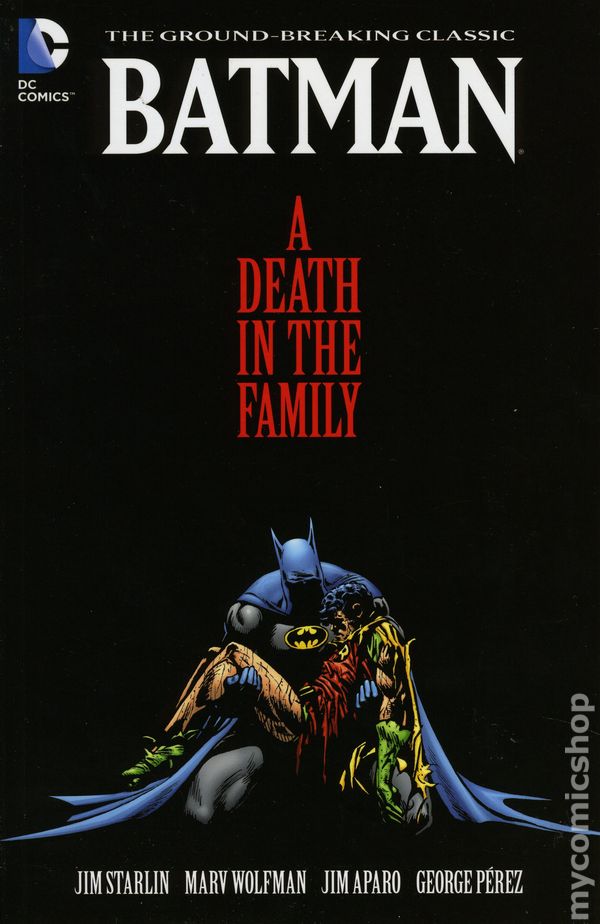Mild-mannered reporters by day, Greg Phillips and Nick Duke share an intense love of comic books that has made them the Hard-Traveling Fanboys. And if there’s anything that fanboys love, it’s debating what book is better than another book or which character is “cooler.” Enter Countdown, a monthly column where Greg and Nick will give a top five list and debate the merits therein.
Greg: Hi there. We’re the Hard-Traveling Fanboys. You might remember us from such infrequently appearing columns as Off the Page and The Longbook Hunters. We’re back this week with the latest installment of Countdown. Comic books have a long and gory tradition of killing off characters both major and minor. With one of Marvel’s most iconic characters set to bite the dust soon in Death of Wolverine, what better time is there for us to talk about our favorite comic book deaths? These are the deaths that made a huge impact on us as readers, the deaths that most impacted our favorite characters or the death stories that just plain delivered.
Nick: Yes, Countdown, a column that in no way was the last column we wrote. In any event, we’re here to discuss the deaths that hit us the hardest.
So, before we decide to take another six-week hiatus, let’s see Greg’s No. 5 choice.
Greg’s No. 5: Jason Todd (Batman #428)
Nick: Look at Greg getting all fancy with issue numbers and whatnot.
In any event, I’m largely going to withhold comment for now. But, suffice it to say that there may not be a more important death in the Batman mythos outside of the deaths of Thomas and Martha Wayne. This death defined not just the life of Jason Todd, but the life of Bruce Wayne for many years.
Greg: This was one of those “Where were you?” moments in comics. Jason Todd was never beloved by fans as the second Robin. As comic fans are wont to do, many spent Todd’s tenure complaining and begging DC to reinstate Dick Grayson as the Boy Wonder. And, frankly, their concerns may have been warranted — Jason was written to be essentially a clone of Dick, personality-wise, and then morphed into a hot-headed punk who couldn’t take orders.
It was after much fan backlash that DC decided to take a phone poll to decide the character’s fate — life or death. Even with all the backlash, surely the company wouldn’t kill off Robin, right? Wrong.
While “A Death in the Family” isn’t one of the better Batman stories on the whole, the death of Jason would become one of the most iconic in the genre. The Joker’s brutal crowbar-wielding beatdown on Jason was the real highlight of the story, but the reason this death makes my list is twofold: 1) Jim Aparo’s wonderful panels that captured the terror experienced by Jason and the dread of Batman as he rushed in a vain attempt to save his fallen comrade, and 2) The massive, incalculable impact it had on Batman comics moving forward.

I have long made the argument that Jason’s death was actually more important to Batman’s mission later in his career than his parents’ death. Frankly, after so many years of fighting for their memory, it became somewhat difficult to relate to Bruce never getting closure on that matter. What Jason’s death did was add a new layer of pathos to Bruce Wayne. Here, his attempts at saving a young life by recruiting him to his cause directly resulted in that life coming to an end. Jason’s death was ultimately on Bruce, and it was Bruce’s guilt, anger and, ultimately, renewed drive that became the focus of the Bat-books for more than a decade.
The teases of the character’s return over the year only added to Bruce’s misery. Here was a constant reminder of his greatest failure, and the reason he must never get complacent in his mission.
Nick: Perfectly stated, sir.
And, much like Jason’s death motivated Bruce, my No. 5 choice served as a motivator and left a lasting impact on ol’ Webhead.
Nick’s No. 5: Gwen Stacy (The Amazing Spider-Man #121)
Greg: It doesn’t get much more iconic than the death of Peter Parker’s first true love. This was mind-blowing at a time when comics weren’t littered with major character deaths on a seemingly monthly basis.
Nick: If we’re talking about deaths that actually matter, it’s hard to come up with many more important than this one. Outside of the massive impact it had on Peter Parker as a character and Spider-Man as a concept, look at how huge it was in terms of the comic book industry as a whole.
Before 1973, the thought of truly killing off such a prominent character was unheard of. Deaths were saved only for ancillary characters or instantly wiped away. So, did anyone ever think it possible that Marvel might see fit to kill off Spider-Man’s one true love? The story outdates me by more than 14 years, but everyone I’ve ever talked to who read it as it happened has mentioned just show shocking and heartbreaking it truly was. This was one of the few examples of a hero truly failing outside of their origin story, and many have pointed to this story as one of the milestones that brought an end to the Silver Age and ushered in the Bronze Age.
But it isn’t just enough to be shocking or to make an industry-wide impact. No, a great death should first and foremost cause unforgettable shockwaves in a character’s journey. And for Peter Parker, the death of Gwen served as a reminder that his story, no matter how many highs it may reach, is ultimately about personal loss and tragedy. Things had been looking up for the wall crawler since the death of his Uncle Ben, and he and Gwen seem destined to spend their lives together. However, one night changed all of that.

Even more interesting is the question of who truly killed Gwen Stacy: Was it the Green Goblin tossing her off the bridge or Spider-Man’s webs that took her life? That little ‘snap’ is so important to the years that followed. Spider-Man couldn’t help but blame himself, and has even referenced the event by reminding himself to protect every joint when saving someone from a steep fall. No matter who you ultimately believe to be Gwen’s true killer, her death served to firmly establish Norman Osborn as Spider-Man’s arch-nemesis and helped to set Peter on a new path of redemption and, ultimately, love, setting the stage for the Mary Jane/Peter romance we all know and hold dear.
Greg: Like Robin’s death did for Batman, Gwen’s death both changed and enhanced Spider-Man’s story. Peter now had to deal with an even greater failure than in the case of his uncle’s untimely demise. The story opened up so many levels to Spidey’s journey — dealing with grief, pursuing villains more aggressively and, perhaps most interestingly, battling the question of how close he could ever truly be to another person. If the woman he loved most could be taken from him so swiftly, it could happen to anyone who entered his life.
Many characters and comics have copied this general story arc, but few have ever approached its importance or execution.
Greg’s No. 4: Jean Grey (New X-Men #148, 150)
Nick: This is actually the basis for a future edition of Countdown, in which we’ll discuss the top five Jean Grey deaths!
All jokes about Jean’s multiple deaths aside, her death has left a huge impact on her fellow X-Men, especially Cyclops.
Greg: You read that right. I’m a blasphemer who is not going with the most iconic Jean Grey death, 1980’s Uncanny X-Men #137. Instead, I’m going with two Grant Morrison-penned issues that spoke to me more personally because I read them not long after they were released (well, in trade form) and came at the end of an X-Men run I’d been reading for months.
Nick: I’m largely unfamiliar with this particular Jean death, so I’ll sit back and listen.
Greg: Though I’ve been somewhat critical of Morrison in the past, I am one of the most ardent defenders of his New X-Men run. True, it displayed some of his trademark out-of-character portrayals, but in my eyes, the Scotsman’s zaniness has never been more focused. His take on the X-Men was wildly different from any that came before or after, yet it rejuvenated many of these characters who had become stale and boring.
One of the most maligned aspects of Morrison’s run by longtime fans was the psychic affair between Cyclops and Emma Frost. While it may have been out of character and frustrating to longtime fans, it also made Cyclops interesting for the first time in ages and brought Jean back to the forefront for one last hurrah. And what a hurrah it was, complete with Morrison’s distinctive flair.
Magneto, who had been disguised as new X-Man Xorn, was exposed. This, of course, angered him. He trapped Wolverine and Jean (of all people!) on Asteroid M and sent them hurtling toward the sun.
Together at last, Logan and Jean share a moment before Jean begins to die a slow death. In the ultimate moment of love, despair and compassion, Wolverine stabs her through the chest, taking the life of the woman he loved but could never truly be with. It’s one of the most touching scenes Morrison has ever written.
And then the Phoenix Force brought Jean back, only for Magneto to kill her for good in New X-Men #150, giving her a “planetary” stroke and leaving her to die in Scott’s arms with these final words, which have a hint of “Tombstone” and a whole lot of glorious X-Men soap opera: “Live, Scott. Live. All I ever did was die on you.”

The Wolverine scene in particular still gets to me all these years later, probably because Logan is my favorite Marvel hero and I identified with the unique relationship he shared with Jean.
Nick: What, pray tell, is a “planetary” stroke?
Greg: Well, it’s actually just a massive stroke that’s on a “planetary scale” — courtesy a gigantic electromagnetic pulse from Magneto, who was juiced up from a mutant power-enhancing drug. Because comics. And Morrison.
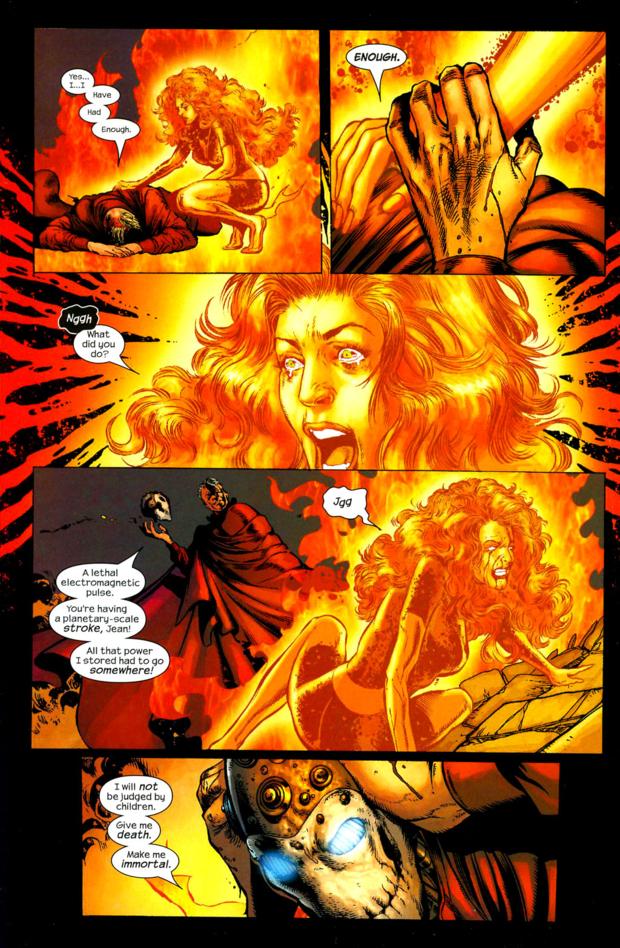
Nick: Hmmmm.
Greg: Drug addict Magneto was an element of Morrison’s run I did NOT love, but that’s another story for another time. On the whole, like Preparation H, Morrison’s run felt good.
Nick: In any event, those final words are poignant, and it makes sense to have Jean’s final death in the story come in the arms of Scott, no matter how much you or I may prefer Logan.
Greg: No argument there.
Nick’s No. 4: Superman (Superman #75)
Nick: This is probably a bit low for most people, but you have to remember that I’m not the world’s biggest fan of the Big Blue Boy Scout. That being said, it’s hard to debate the Death of Superman’s place as one of comics’ most iconic moments and stories.
You’ve likely heard the details of Superman’s death countless times, so I won’t bore you with them here. I particularly loved how the death was eventually built to, as over the course of four issues, the story progressed from all four-panel pages to all three-panel pages to two panels and, finally, an issue of 22 single-panel pages. In the end, Clark dies in Lois’ arms, providing one of the greatest images in comics history.
However, as with many other entries on this list, it isn’t the death itself, but the impact it has that makes it great. Stories like “Reign of the Supermen” and “Funeral for a Friend” helped to set the stage for Superman’s eventual return, and helped to remind us all that even in an era where readers were becoming increasingly cynical and desired darker stories and characters, there was still a place in the world for truth, justice and the American way. In the end, Superman’s death helped to show us all why he still mattered and why no one could ever take his place, both literally and figuratively.
Greg: We got a chance to talk a lot about this death in our inaugural Giant-Size column, and it was a blast for me because of what an impact this story and death had on me at a very early age.
The importance, whether positive or negative, can’t be overstated. This story was huge. And I think the execution was a lot better than it’s given credit for in many discussions of great Superman stories. More on this subject from me a little later on.
Greg’s No. 3: Harry Osborn/Green Goblin (Spectacular Spider-Man #200)
Nick: Peter’s lost family, lovers and, in the case of Harry Osborn, his best friend. Harry’s death was truly tragic, as it represented another person Peter failed to protect, although it was nearly impossible for Peter to protect Harry from himself.
Greg: I had the distinct pleasure of reading this issue when it came out. To be completely honest, 9-year-old Greg was probably attracted by the shiny foil cover and the double-sized page count. But what was inside was truly astonishing, another testament to the greatness of writer J.M. DeMatteis.
Harry had fully taken up his father’s mantle as Green Goblin by this point, blaming Peter Parker for the deaths of both his father and their mutual friend, Gwen. His mind and mood shifted wildly due to the “new and improved” Goblin serum he’d recently taken. Complicating matters, Harry had a family — his wife, Liz, and son, Norman.
What’s made clear as the issue progresses is that Harry still loves his family. He even loves Mary Jane, as he kidnaps her and takes her to the same bridge that began all their troubles, only to tell her he would never put her in danger. But the one thing still eating away with him is the burning need for revenge on Peter.
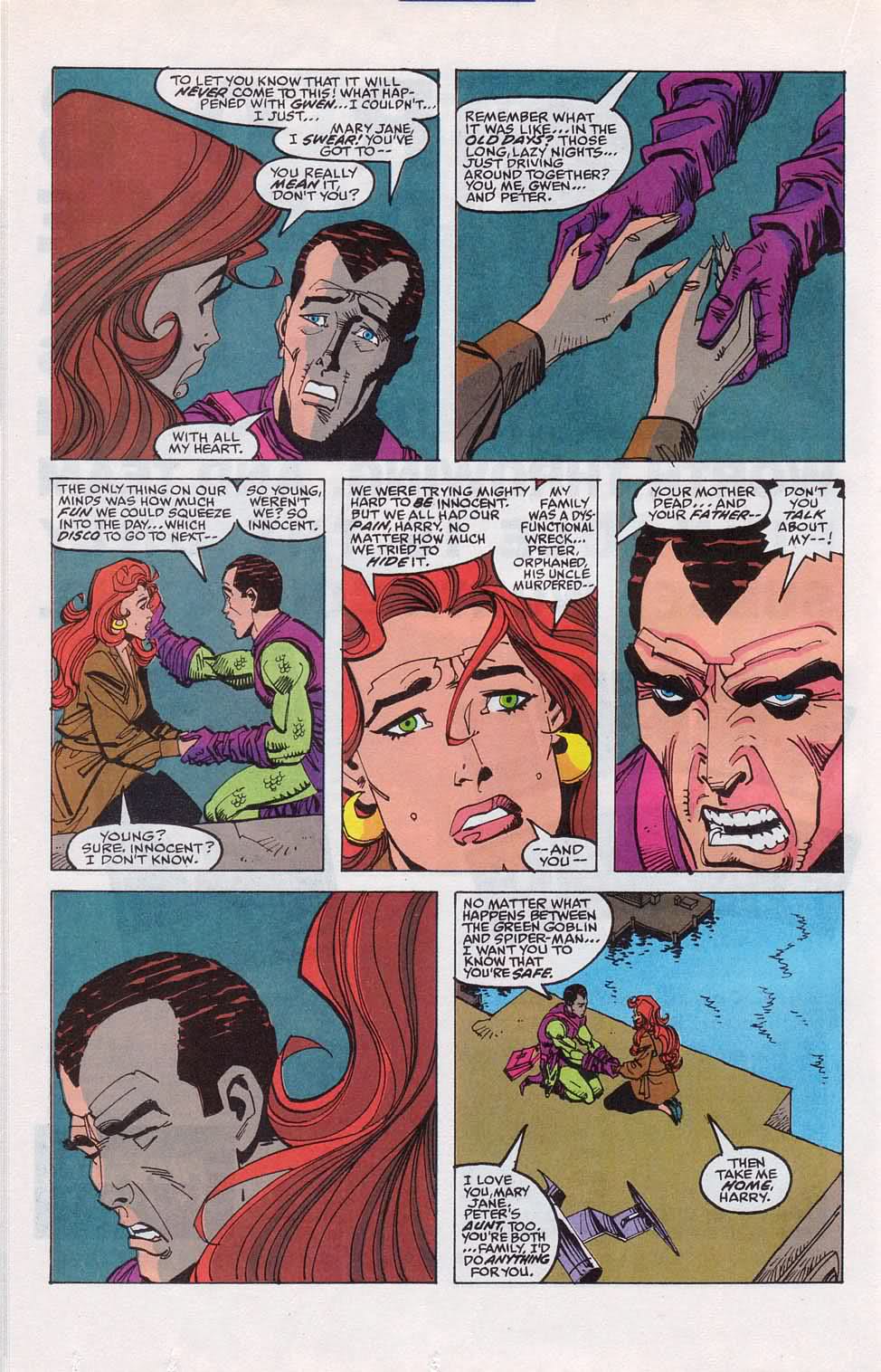
Yet at the end, with madness eating away at him, Harry inadvertently puts Normie and MJ in a life-threatening situation. At Peter’s urging, Harry manages to save them. And finally, in his last act on Earth, Harry has a simple decision — leave his rival to die or go back into the burning building to save his former best friend.

Harry’s choice proved once and for all that he was not like his father in the ways that mattered most. It was a touching scene, one of the most emotional in ’90s superhero comics. It stands as one of my favorite single issues, and Harry’s heartfelt goodbye to Peter will always stand out. “What else could I do? You’re my best friend.” Hang on, I think there’s something in my eye.
Nick: It was also the rare death that stood the test of time, as Harry stayed dead for 14 years, not resurfacing until 2007 in the wake of “Brand New Day.” But, the less said about that, the better.
Greg: Indeed. It was one of the lazier retcons in recent memory.
Nick’s No. 3: The Flash — Barry Allen (Crisis on Infinite Earths #8)
Greg: Another death that stood the test of time for more than 20 years, and one that had a major impact on the DC Universe.
Nick: Crisis on Infinite Earths had a handful of notable deaths, but none were more heartwrenching than that of Barry Allen. Barry had been used extensively in the series, and largely served as the eyes through which the reader experienced the story. By the story’s climax, it was up to Barry to stop the Anti-Monitor’s anti-matter cannon, which he did by using his powers to absorb the anti-matter. That of course led to his death, which to that point was probably the most notable death DC had gone through with in company history.
But what truly makes it stand out to me is the price that Barry wound paying. He had recently retired and found happiness in a new life with Iris, his longtime love. It would have been very easy for Barry to turn away from the burden that only he could shoulder, but in the end, he served as a shining example of heroism by running fearlessly into his demise.
And, as Greg said, the death actually stuck. It lasted more than 20 years, and established Barry in the memories of the entire DCU as someone to strive to be like. It also set the stage for Wally West to take up the mantle, creating a new Flash that proved to be just as iconic as Barry.
Greg: Barry’s death did an interesting thing in that it turned Barry into the post-Crisis DC Universe’s new symbol of sacrifice and heroism. For the bulk of the next 25 years, Barry’s sacrifice loomed large in the background of not just Flash stories but every corner of the DCU. It proved particularly poignant during major crossover events like Zero Hour and Infinite Crisis, and writers like Mark Waid and Geoff Johns never failed to remind readers how important Barry Allen was. In many ways, his death actually enhanced the character.
Nick: Absolutely. It’s the rare instance where killing a character actually makes him more important and iconic in the long run. Plus, the way his death was held up as a symbol of sacrifice only served to make his eventual return that much more impactful.
Greg: It also opened up a real, genuine opportunity to create a legacy character and proved that path can work. Two decades with a replacement character is a far cry from the one or two years we see so often in the modern era.

I think Barry’s death also served to elevate the Anti-Monitor’s standing in DC villains, cementing him as a REALLY “big bad” who caused business to pick up on the rare occasions he arrived.
Greg’s No. 2: Hollis Mason (Watchmen #8)
Greg: Truthfully, I could’ve put both Rorschach and the Comedian on this list. Since I felt the need to narrow it down to one, I went with the death that made the most impact on me in what I consider the best comic book/graphic novel/whatever in the medium’s history.
Nick: Hell of a choice. I’ll admit the prospect of including a Watchmen character never entered my mind, but this one certainly tugged at the heartstrings.
Greg: What a lot of people may forget about Watchmen, because it’s often lost in other adaptations and discussions about the book, is that much of the back story is told through Hollis Mason’s eyes. Everything we know about the past in Alan Moore and Dave Gibbons’ transcendent work is told to us through Hollis’ autobiography or other stories from or about him. It’s Hollis who gives us our perceptions of the Minutemen, and it’s Hollis who puts into perspective just how much of a game changer Dr. Manhattan proved to be.
And in the dystopian, cynical world of Watchmen, Hollis stands out because he’s a genuinely good man. He’s a throwback, a sort of stand-in for the traditional comic book superhero the story mostly lampoons. He’s just a normal guy who fought crime because it was the right thing to do, had some fun along the way and retired without incident.
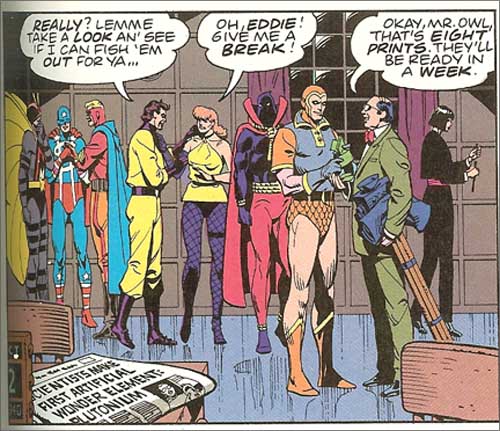
The fact that he suffers such a brutal, inglorious death (spectacularly rendered by Gibbons, who used flashbacks to counter the brutal beating with Hollis’ adventuring days) serves as such a gut punch to the reader. In my case, I found myself literally shaking while reading it — furious that such a wonderful character came to a brutal end. And perhaps the scene was something of a meta statement or, at the least, a predictor of things to come, as the values and ideals of the Golden and Silver Age heroes would be bludgeoned repeatedly at times in subsequent decades.
In any event, it’s one of the most piercing scenes in one of the greatest works ever crafted in the world of comics.
Nick: You mentioned Rorschach and the Comedian, but those characters, like virtually every other character who dies in the book, ultimately deserve the fates that befell them. Watchmen is a work filled with terrible, deeply flawed people, yet it’s the best of those people — the one shining knight — who dies in the most brutal fashion. It’s tough to swallow.
Greg: And who can forget the scene when Nite Owl II loses it in the bar after finding out about his mentor’s death? Chilling, powerful stuff.
Nick’s No. 2: Jason Todd
Greg: The second teen to wear the cape and boots of Robin met a vicious end at the hands of the Joker, and as we discussed earlier, its impact was explored wonderfully in the following years.

Nick: Greg covered Jason’s death wonderfully earlier in the column, but I’ll offer my few brief thoughts here.
Jason’s death wasn’t really about the fact that the fans were losing a Robin, but rather what it meant for Bruce Wayne and the Batman line going forward. Simply put, Jason’s death represented Batman’s ultimate failure. Bruce had been used to coming out on top for so long that when he was unable to protect his adopted son, it shook him to his very core. It made him self-conscious at times. It made him even more obsessed. It made him paranoid. It shaped the next 15 years of Batman stories, and provided the writers of the 90s with countless interesting directions to take the character.
No matter what Bruce encountered or overcame, he kept Jason’s costume on display in the Batcave, not only in honor of Jason’s memory, but to remind Bruce of what failure could cost him in the future. Even in death, Robin was there to keep Batman accountable and remind him of what was at stake.
Greg: While Jason’s death lasted a lot longer than my pick for No. 1, no death produced more raw emotion from me the first time I read it.
Greg’s No. 1: Superman (Superman #75)
Nick: Hard to argue putting this at No. 1, as it’s the death that’s likely the most widely known in the world at large. The Death of Superman made legitimate newspaper headlines, and it’s hard to find someone who doesn’t have at least a passing knowledge of the story.
Greg: I could indeed champion the sales alone to support this selection, or I could point to the mainstream coverage or the impact it had on the business.
Instead I’ll focus on the effect it had on me as an 8-year-old boy who loved Superman above all other comic book characters. This was the very first comic book that made me cry, and it made me cry harder than any that would follow. As you mentioned earlier, Nick, the build-up to it was so clever (decreasing the number of panels with each issue) that I didn’t realize why the fight felt bigger and bigger with each issue. And though the advertising campaign kept promising doom for the Man of Steel, I still couldn’t believe it. No way would they actually pull the trigger, and no way was some raging monster going to take out my favorite hero.
Folks, those last five pages delivered the equivalent of a knockout blow to my emotions. As it became more and more apparent Superman was going to bite the dust, I felt the tears building. And then, with Lois cradling Superman in her arms and onlookers gasping, it became all too real with an exchange that went something like this:
Bloodwynd (don’t ask): It cannot end this way.
Omniscient Narrator (in the douchiest, most matter-of-fact way possible): But it will.
ANGER. RAGE. Realization. Despair. A whole bunch of tears.

As I struggled to keep from crying on the book, I turned the page to see Superman’s journey (seemingly) come to an end. As I finished it, I honestly had no clue that he would be back. All I knew was he was dead, and he’d given his life to save the planet from an unstoppable force. It was incredibly impactful and is the story that cemented Superman as the ultimate hero in my eyes.
Nick: A beautiful description, sir.
And much like the death of Superman caused you to see the downfall of your ultimate hero, my No. 1 did the same for me.
Nick’s No. 1: Ultimate Spider-Man (Ultimate Comics: Spider-Man #160)
 Greg: You’ve written extensively about this title and character, but outside the podcast, you haven’t gotten many opportunities to really talk about why the death meant so much to you.
Greg: You’ve written extensively about this title and character, but outside the podcast, you haven’t gotten many opportunities to really talk about why the death meant so much to you.
While I haven’t read that far into Ultimate Spider-Man, I can imagine that after one writer crafted this character for so many years, it would be heartbreaking to part with him as a fan.
Nick: At this point, anybody who’s read more than a handful of our columns knows all about my love for Marvel’s Ultimate universe. It was what finally brought me into comics, and it was specifically Brian Michael Bendis’ Ultimate Spider-Man that made me a fan. I’ve been with the character since the beginning, and was there every step of the way as Peter experienced love, loss, triumph and despair. I never wanted it to end, and since I could look across at mainstream comics and see things like Action Comics and Detective Comics reaching 700 issues, I thought it never would.
But then, news broke that Bendis was planning a story called “Death of Spider-Man.” Surely, I thought, it’s a figurative death, not a literal one. However, I soon found out otherwise. At this point in the character’s history, Peter was taking instruction from Captain America in an effort to help Peter become the best hero he could be. When Punisher took a shot at Cap, Peter threw himself in front of the bullet, severely wounding him. At the same time, Norman Osborn and the remnants of the Ultimate Six escaped from SHIELD custody and made for Queens to strike at Peter and his family.
There, on his front lawn, his mask ripped away, his identity exposed and literally bleeding to death, Peter mounts one final stand against Norman Osborn, the man who had tormented him constantly since the series’ start. And, as he had done so many times before, Peter saved Mary Jane and Aunt May, giving his final breaths to stop the Green Goblin.
Finally, Peter succumbed to his cumulative wounds, dying in the arms of Aunt May, saying to her as he died, “It’s okay… I did it. Don’t you see… it’s okay. I did it. I couldn’t save him. Uncle Ben. I couldn’t save him… no matter what I did. But I saved you. I did it. I did…” The last shot of theseries shows Mary Jane cradling Peter’s lifeless body in a clear allusion to the Death of Superman as she screams in agony.
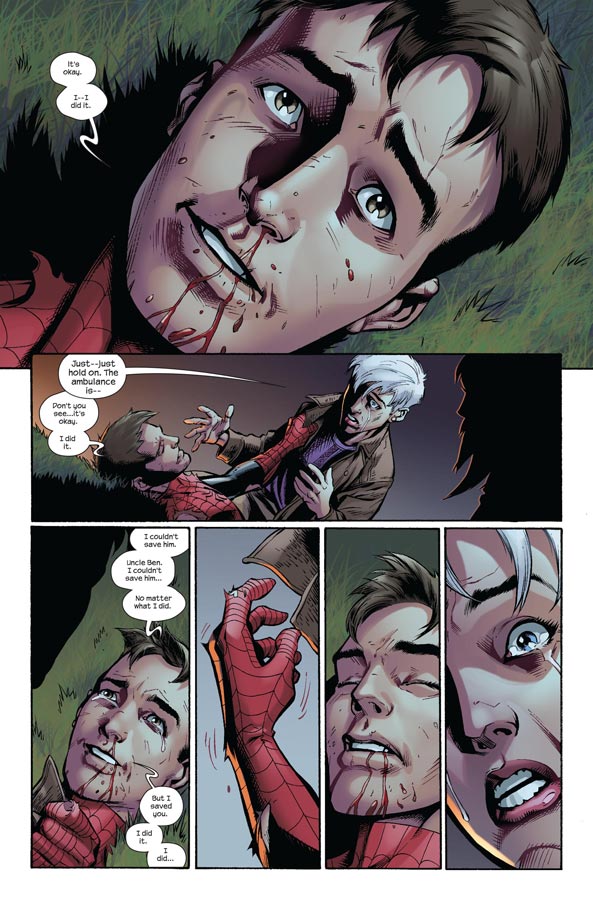
Greg: One day, I hope to read all the Ultimate Spider-Man issues leading up to that one. It sounds like an incredibly intense read, and the great comics are the ones that can provide genuine emotional response.
Nick: But as much as Peter’s death hit me in the softest parts of my heart, it was the excellent series “Ultimate Fallout” that took that to a whole other level. In the pages of Fallout, we see each character dealing with Peter’s death in their own way. Kitty Pryde cannot process it and goes into hiding. Mary Jane is convinced that Nick Fury is to blame and will not stop until she proves it. Aunt May is trying to reconcile the fact that she has no family left with the newfound fame Peter’s exposed identity has brought her. At Peter’s memorial, which is attended by tens of thousands of New Yorkers, she publicly dresses down Captain America for never respecting Peter, even though Peter idolized him and ultimately sacrificed himself to save him. Mary Jane ultimately comes face to face with Fury, screaming at him and breaking down in tears in front of him. In one of his ost sincere moments, Fury takes full responsibility for Peter’s death and even sheds a tear himself.
But perhaps most importantly, we see how Peter’s death has inspired a new hero. We learn that Miles Morales, the boy who we now know would become Spider-Man, obtained his Spider powers. We see how he was afraid of his power and refused to use it. We see how seeing news coverage of Peter fighting Osborn spurs Miles into action, causing him to head for Queens to intervene. And we see Miles arriving too late to save his childhood hero, making Peter’s death Miles’ version of what Uncle Ben’s death was to Peter.
I could go on and on, but the important thing is that even more than Peter’s death, the ramifications that resulted from it continue to be felt and continue to resonate emotionally, even as the Ultimate line sputters. The DCU had Barry Allen for 20 years as its shining example — the Ultimate universe has its greatest hero, Peter Parker.
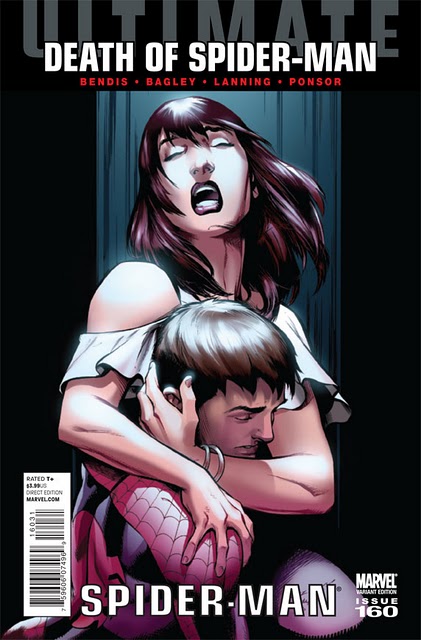
Greg: And “Ultimate Fallout” sounds a lot like “Funeral for a Friend” and “World Without a Superman,” which took a good death story and used it as the lynchpin for even better stories.
Nick: That’s a perfect comparison. To me, “Death of Spider-Man” without “Fallout” is just incomplete. They will always be one story to me, and should be read in conjunction by anyone who picks up the series.
In any event, we’ve reached the end of our Countdown.
As always, we welcome your feedback on Facebook, Twitter (@gphillips8652 and @nickduke87) and on our PTB email accounts (GregP@placetobenation.com and NickD@placetobenation.com).
Be sure to check us out next week, when we delve into our longboxes for a look at Mark Millar’s Kick-Ass.
Greg: And if there’s one thing you can count on us to do, it’s be on time.
